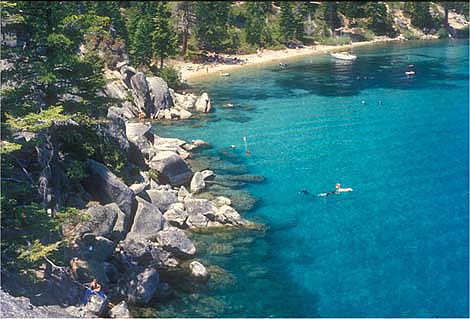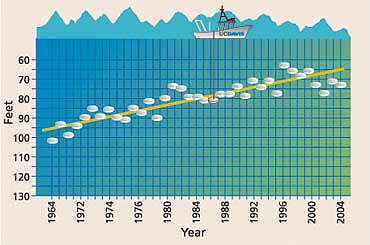All Issues
Models clarify Tahoe clarity loss
Publication Information
California Agriculture 60(2):49-52.
Published April 01, 2006
PDF | Citation | Permissions
Abstract
Tahoe is one of the most beautiful lakes in the world, with such clear blue water that you could once see to depths of more than 100 feet. But Lake Tahoe's extraordinary clarity has declined for half a century and today you can usually only see to depths of about 70 feet.
Full text
While the water has gotten less clear, UC researchers have elucidated one important thing: the causes for the murkiness. Just about anything in the Tahoe Basin from eroded soil to air pollutants can end up in the lake, so restoring its clarity will require basinwide management. To help guide this process, UC Davis researchers have developed a model that accounts for what gets into the lake, where it goes once it's in the lake, and finally how it all affects clarity.
“The model connects land-use and policy decisions to what's actually going on in the lake,” says Ted Swift, who worked on the lake clarity model while at UC Davis and is now an environmental scientist at the Department of Water Resources in Sacramento.
Lake Tahoe is so clear because it is very deep and the water that goes into it is very pure. The lake reaches a depth of about 1,650 feet, making it among the 10 deepest worldwide and one of the deepest nationwide, second only to Oregon's Crater Lake, which reaches a depth of about 1,950 feet.
The water that goes into Lake Tahoe is so pure for two reasons, Swift explains. First, much of it falls directly into the lake as rain or snow because the watershed is small relative to the lake's surface area (roughly 300 square miles vs. 200 square miles). Second, the water that drains into the lake has historically been low in nutrients and sediments, Swift says, partly because the watershed is small and partly because it is mostly granite so the soils are relatively sterile.
Why is clarity declining?
“Old-timers say Lake Tahoe is not as clear and blue as it used to be. It's still beautiful but it is gradually getting milkier and greener,” Swift says. The research documenting the lake's 30% clarity decline was pioneered by UC Davis limnologist Charles Goldman ( see page 45 ), who in the late 1960s began systematically measuring its Secchi depths. This simple but powerful technique entails lowering an 8-inch white disk until it can no longer be seen by the naked eye, yielding annual averages based on more than 30 measurements taken regularly over the course of each year (see figure).
Historically, erosion into Lake Tahoe has been low because of the high percentage of granite and granitic soils in the watershed.
The two main culprits in the clarity decline are excess nutrients and sediments. Nutrients — particularly phosphorus but also nitrogen — increase the growth of algae, which in turn absorb and scatter light. The growth rate of algae near the lake surface has qua drupled over the last 35 years ( see figure, page 46 ). Sediments both carry nutrients and scatter light themselves, and more than 10 tons of sediment are added to the lake each year from sources including erosion from development, road dust and engine exhaust.
For more info:
Pathway 2007 factsheet:
www.tiims.org/tiimswebsite/ContentProjects/Pathway2007/factsheets/Pathway2007.pdf
Tahoe Environmental
Research Center:
Contaminants enter the lake in streamflow and fall directly onto its surface from the air — and then they persist because the lake has such limited outflow that water stays for an average of 700 years.
Using the white Secchi disk to measure water transparency, UC Davis scientists have documented a decline in Lake Tahoe's clarity.
Brant Allen (middle) of TERC and Jeremy Sokulsky (top) of the Lahontan water board lower the Secchi disk into Lake Tahoe. While visibility is sometimes as deep as 130 feet, the trend is toward declining clarity.
Role of lake mixing
Equally important is where all the contaminants go once they are in the lake. “The muck we see is in the top 300 feet,” Swift says.
The destination of contaminant-laden stream-flow depends on its temperature relative to the lake: when the streamflow is warmer, it shoots across the surface; when the streamflow is colder, it plunges toward the bottom. While contaminants can also settle to bottom, it takes years for the smallest particles to get there. And even then, they can come back up.
The analysis of satellite data has revealed that water jets rise from the depths and go shooting across the lake. The jets are several miles wide and “can go clear across the lake in half a day,” says Geoffrey Schladow, a UC Davis environmental engineer who directs the Tahoe Environmental Research Center (TERC). “It took us by surprise.” Driven by winter winds, these water jets typically mix the lake only about three-fifths of the way down, but every few years they mix it completely to the bottom.
Contaminants and visibility
The next step is determining how the contaminants affect visibility in the surface waters of Lake Tahoe. Swift and colleagues developed an optical model of the lake that predicts Secchi depths based on factors including algae and sediments (Aquatic Sciences, in press). The model showed that sediments account for more than half of the lake's clarity loss, and that the smallest particles (less than 8 microns) have the biggest impact.
In addition, the optical model accurately predicts seasonal dips in clarity that are observed in December and June. During winter, the top 150 or so feet of water cools and the wind then mixes the lake, bringing algae, nutrients and sediments up from deeper waters. During summer, the stream-flow is relatively warm and so spreads across the lake's surface waters, concentrating the fine particles it carries there. “The small volume of stream water has an amplified effect on clarity,” Swift says.
Based on the various factors that affect visibility, from contaminants to lake mixing to optics, TERC researchers developed a comprehensive clarity model that predicts Tahoe's Secchi depths. Contaminants from streams are estimated based on monitoring a subset of the 63 streams that feed into the lake, while contaminants from the air are monitored by the California Air Resources Board. Lake mixing is driven by the local weather, which is monitored by TERC. So far, the lake clarity model has been tested on Secchi depths that have already been observed. “The model agrees very well with the last 3 to 4 years of data,” Schladow says. “Next we'll project the lake's clarity over the next 20 years under various management scenarios.”
Restoring clarity
The current management goal, which was set by the Tahoe Regional Planning Agency ( see sidebar, page 50 ), is to restore the lake's clarity to that of the early 1970s, when the Secchi depth was about 95 feet. However, whether this goal can be reached remains to be seen. “I think it's achievable to stop the decline and improve the clarity,” Schladow says. “I don't know if we can reach 95 feet. It depends on what the model shows about the sources [of contaminants].”
Lake Tahoe's popularity as a tourist destination has increased substantially since the 1950s, bringing with it increased pressure on its limited resources. Above, a fishing derby at Sawmill Pond.
One barrier to restoring Lake Tahoe is that the contaminant sources and their relative impacts are not yet fully understood. For example, while recent research shows that the atmospheric nutrients in the lake are primarily from within the Tahoe Basin ( see page 53 ), the primary atmospheric sources of fine sediments remain unknown. If the latter are mostly from the Central Valley, they will be harder to control than if they are mostly from within the Tahoe Basin. “We need to identify where gains can be made,” Schladow says.
Similarly, the relationships between Tahoe Basin land uses and lake clarity are not well understood. TERC researchers are currently investigating the effects of land uses — from forests ( see page 65 ) and wetlands to development and ski areas. Recent research shows that local urban forests may affect biodiversity and ecosystem function ( see page 59 ).
Another big unknown is how climate change will affect the lake's clarity. Temperatures in large lakes worldwide are rising about twice as fast as those in oceans, and UC Davis ecologist Robert Coats has found that Lake Tahoe has warmed nearly 0.9° F over the last 30 years. Warmer waters could mean less mixing, which could make clarity either better or worse: the former by keeping more nutrients in the depths, and the latter by not diluting sediments in the surface. “There are two competing processes,” Schladow says. “We're learning not to be foolish enough to say ‘this is going to happen next year’.”
Warming could also favor different kinds of algae than those that currently dominate Lake Tahoe. While the lake has hundreds of algal species, only about a dozen dominate during any given time period and they can have very different effects on clarity. At its clearest, the lake was dominated by diatoms, which are compact and so scatter light less, but now the lake has lots of algae that have long filaments and so scatter light more.
Reasons for hope
Despite the progressive decline in clarity and the many unknowns, hope remains for restoring Lake Tahoe. There are still days when the lake is so clear that you can see to depths of 130 feet or more, and the annual clarity improves by as much as 3 feet during drought years, when streamflow and thus nutrient and sediment levels are low. This suggests that controlling erosion could have a huge impact, which makes sense because the lake has a natural cleaning process in that sediments eventually do settle to the bottom.
Encouragingly, erosion control may indeed be feasible in the Tahoe Basin. Recent research shows that fine sediments in runoff can be reduced by a combination of soil restoration and pine needle mulch ( see page 72 ) as well as other treatments ( see page 77 ). In addition, most of the wetlands around the lake have been lost to development, and restoring them is a promising way to keep sediments and nutrients from reaching the lake. “If we can bring these levels back down, the lake has a fair chance of regaining much of its fabled clarity,” Swift says.








